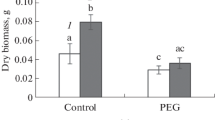Abstract
Eight to nine months old seedlings of the Cactaceae Gereus validus HAWORTH grown in soil culture were chosen to study day-night cycles of net CO2 exchange, indicating the stomatal rhythm of crassulacean acid metabolism, CAM, in relation to day-night changes of abscisic-acid levels. Drought stress was imposed by repotting the seedlings in dry sand and keeping them without watering for up to 37–39 days while control plants were watered regularly. Abscisicacid levels were higher in the stressed plants than in the controls and higher in the light period aa compared to the dark period. In the stressed plants abscisic-acid levels increased throughout the light period. Abscisic acid reached particularly high levels in the late afternoon in plants stressed for 37 days. It is conceivable that stomatal closure during the first part of the light period of CAM is elicited by high internal partial pressures of CO2 built up by decarboxylation of nocturnally stored malic acid. However, the elimination of late-afternoon stomatal opening and the reduction of stomatal opening during the dark period of CAM observed under conditions of drought stress must have other reasons. The analyses of abscisic acid presented allow the conclusion that this stress hormone is involved in stomatal regulation of CAM under such conditions.
Similar content being viewed by others
References
Brulfert, J., Kluge, M., Guerrier, D., Queiroz, O.: Characterization of carbon metabolism inOpuntia ficus-indica Mill, exhibiting the idling mode of crassulacean acid metabolism. - Planta170: 92–98, 1987.
Cockburn, W., Ting, I. P., Sternberg, L. O.: Relationship between stomatal behaviour and the internal carbon dioxide concentrations in crassulacean acid metabolism plants. - Plant Physiol.63: 1029–1032, 1979.
Dörffling, K., Tietz, D., Streich, J., Ludewig, M.: Studies on the role of abscisic acid in stomatal movements. - In: Skoog, F. (ed.): Plant Growth Substances. Pp. 274–285. Springer-Verlag, Berlin-Heidelberg-New York 1980.
Friemert, V., Kluge, M., Smith, J. A. C: Net CO2 output by CAM plants in the light: the role of leaf conductance. - Physiol. Plant.68: 353–358, 1986.
Hohorst, H. J.: L-(-)-Malat, Bestimmung mit Malatdehydrogenase und NAD. - In: Bergmeyer, H.U. (ed): Methoden der enzymatischen Analyse. Pp. 1544–1548. Verlag Chemie, Weinheim 1970.
Huber, W.: Xanthoxin - ein neues Stresshormon in Pflanzen. - Verhandl. Gesellsch. Ökol. Bremen13: 499–503, 1985.
Kluge, M., Brulfert, J., Queiroz, O.: Diurnal changes n the regulatory properties of PEP- carboxylase in crassulacean acid metabolism (CAM). - Plant Cell Environ.4: 251–256, 1981.
Lüttge, U.: Carbon dioxide and water demand: crassulacean acid metabolism (CAM), a versatile ecological adaptation exemplifying the need for integration in ecophysiological work. - New Phytol.106: 593–629, 1987.
Lüttge, U., Nobel, P. S.: Day-night variations in malate concentration, osmotic pressure, and hydrostatic pressure inCereus validus. - Plant Physiol.75: 804–807, 1984.
Nobel, P. S., Lüttge, U, Heuer, S., Ball, E.: Influence of applied NaCl on crassulacean acid metabolism and ionic levels in a cactus,Cereus validus. - Plant Physiol.75: 799–803, 1984.
Osmond, C. B.: Crassulacean acid metabolism: a curiosity in context. - Annu. Rev. Plant Physiol.29: 379–414, 1978.
Raschke, K.: Die Stomata als Glieder eines schwingungsfähigen CO2-Regelsystems. Experimenteller Nachweis anZea mays L.- Z. Naturforsch.20b: 1261–1270, 1965.
Raschke, K.: Movements of stomata. - In: Haupt, W., Feinleib, M. E. (ed.): Physiology of Movements. (Encyclopedia of Plant Physiology New Series. (Vol. 7.) Pp. 383–441. Springer- Verlag, Berlin-Heidelberg-New York 1979.
Smith, J. A. C, Lüttge, U.: Day-night changes in leaf water relations associated with the rhythm of crassulacean acid metabolism inKalanchoë daigremontiana. - Planta163: 272 to 283, 1985.
Spalding, M. H., Stumpf, D. K., Ku, M. S., Burris, R. H., Edwards, G. E.: Crassulacean acid metabolism and diurnal variations of internal CO2 and O2 concentrations inSedum praealtum D.C. - Aust. J. Plant Physiol.6: 557–569, 1979.
Winter, K.: Crassulacean acid metabolism. - In: Barber, J., Baker, N. R. (ed): Photosynthetic Mechanisms and the Environment. Pp. 329–387. Elsevier, Amsterdam 1985.
Author information
Authors and Affiliations
Rights and permissions
About this article
Cite this article
Huiber, W., Lüttge, U. Day-night cycles of net CO2 exchange in crassulacean acid metabolism as related to day-night changes of abscisic-acid levels. Biol Plant 30, 34–41 (1988). https://doi.org/10.1007/BF02876421
Received:
Accepted:
Issue Date:
DOI: https://doi.org/10.1007/BF02876421




